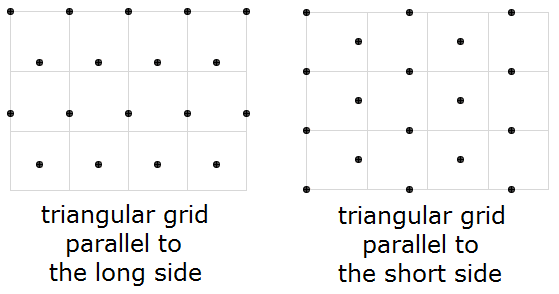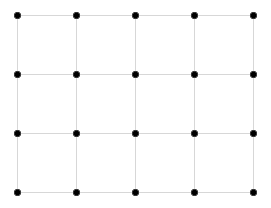Copyright © Had2Know 2010-2025. All Rights Reserved.
Terms of Use | Privacy Policy | Contact
Site Design by E. Emerson
How Many Plants Will Cover a Given Area in My Garden or Lawn?
Rectangular and Triangular Grid Calculator
The number of plants that cover your lawn or garden depends on the spacing between the plants, the size of the area to be covered, and whether you plant them on a triangular grid or rectangular (square) grid.
Accurate estimates will help you purchase the right number of plants and gardening materials. The handy gardening calculator on the left will compute the number of plants if you input the spacing between plants (inches), area to be covered (square feet), and type of grid (rectangular or triangular).
Planting on a Triangular Grid
A triangular grid is based on a lattice of equilateral triangles. Recall that an equilateral triangle has sides with equal length and all angles equal to 60 degrees. If you have to cover a rectangular area, there are two ways you can orient a triangular grid. You can make it run parallel to the long side of the garden, or parallel to the short side of the garden. The figures below illustrate the two orientations.

Both gardens pictured above have dimensions of 3 feet by 4 feet with a plants spaced 1 foot apart on a triangular grid. You can see the difference between the patterns when you plant parallel to the long and short sides. In the examples above, both orientations admit a maximum of 18 plants.
For some rectangles, you can fit more plants on a triangular grid that runs parallel to the long side, while other arrangements admit more plants when you plant parallel to the short side. The calculator above will tell you which orientation to choose.
Planting on a Rectangular (Square) Grid
Planting a cover crop on a rectangular grid is straightforward. You simply divide the area into squares and place a plant at each corner. A rectangular grid runs parallel to both sides of a rectangle, so if your garden happens to be a perfect rectangle, you do not have to worry about the orientation. The diagram below shows how to plant on a rectangular grid.
The example above shows how you can fit 20 plants on a 3 by 4 rectangle using a square grid. However, in general, a triangular grid usually admits more plants than a rectangular grid.
You can also apply these concept if you are planting containers in the ground. Just be sure to measure the distance between the actual plants, not the distance between containers. For example, if you have circular containers with diameters of 5 inches, and you space the containers 1 inch apart, then the distance between plants is 5 + 1 = 6 inches.
© Had2Know 2010
